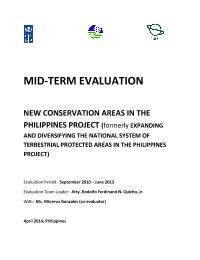
Midterm Evaluation Expanding and Diversifying the National System of Terrestial Protected Areas in the Philippines
Completedon 15 Apr, 2014
Evaluation Plan
Planned End Date
Apr 2014
Evaluation Type
Project
Management Response
Yes
Evaluation Budget
$5,000
Summary
Introduction: NewCAPP and the MTE. Expanding and Diversifying the National System of Terrestrial Protected Areas in the Philippines Project (now known as New Conservation Areas in the Philippines Project or NewCAPP) is a five-year project intended to establish new management regimes for the conservation of terrestrial areas in Key Biodiversity Areas (KBAs) in the Philippines. This proceeds from the recognition that despite its critical importance to global environmental sustainability, the Philippine floral and faunal diversity is faced with several threats. The primary government response is the establishment of the National Integrated Protected Areas System (NIPAS) encompassing more than 200 PAs covering more than 5.4M has of land and water bodies. The NIPAS, however, is faced with three main barriers: (1) small coverage of PAs and underrepresentation of Mindoro, Greater Luzon, Greater Mindanao, Greater Negros Panay and Greater Sulu in the PA system; (2) limited capacities of DENR-PAWB and PAMBs for PA management; and, (3) limited financial sustainability owing to inadequate financial planning, budgetary management and revenue generation.
NewCAPP was thus designed to pilot new conservation areas that shall be outside the NIPAS but still part of the national protected area (PA) system. It has a three-pronged approach (outcomes): (1) establishing and/or enhancing alternatives/models on the ground; (2) capacitating key actors to enhance the management of these alternatives/models, and thereby also benefiting the managers of NIPAS sites in various parts of the country; and, (3) providing a policy basis for the existence, recognition and sustained support for ? thus, mainstreaming - these models and the existing NIPAS sites.
The Project is being implemented in the following pilot sites: (1) Balbalan-Balbalasang National Park (ICCA); (2) Zambales Mountains (ICCA, and LGU-LCA in Mangatarem and Mt. Tapulao); (3) Mts. Irid Angelo and Binuang (ICCA); (4) Mts. Iglit Baco National Park (ICCA); (5) Polilio group of Islands (LGU-LCA); (6) Nug as Lantoy (LGU-LCA); (7) Mt. Nacolod (LGU-LCA); (8) Mt. Hilong-hilong (ICCA); (9) Mt. Kalatungan (ICCA); and, (10) Tawi-tawi Island (LGU-LCA).
Funded by the Global Environment Facility (GEF) and supported by the United Nations Development Programme (UNDP) with the Department of Environment and Natural Resources ? Protected Areas and Wildlife Bureau (DENR-PAWB) as Executing Partner, the project commenced in September 2010 and will end in September 2014.
This is the Mid-term Evaluation (MTE) report of NewCAPP, to determine the project?s progress towards achieving its target outcomes. It also aims to highlight issues requiring decisions and actions, and present initial lessons learned about project design, implementation and management. It covers the first two-and-a-half years of project implementation, specifically from September 2010 until June 2013.
Evaluation Title
Midterm Evaluation Expanding and Diversifying the National System of Terrestial Protected Areas in the Philippines
Atlas Project Number
00071662
Plan Period
Status
Completed
Type
Project
Plan Date
1 Apr, 2014
Completion Date
15 Apr, 2014
Budget
$5,000
Expenditure
$0
Source of Funding
Project funds
Management Response
Yes
Quality Assessment
No
Joint Programme
No
Joint Evaluation
No
GEF Evaluation
Yes
Expand
Stakeholders
DENR-PAWB, NCIP, DENR Regional Offices, LGUs, NGOs
Countries
Philippines
Atlas Project Number
00071662
Plan Period
Status
Completed
Type
Project
Management Response
Yes
Plan Date
1 Apr, 2014
Quality Assessment
No
Completion Date
15 Apr, 2014
Joint Programme
No
Joint Evaluation
No
Budget
$5,000
GEF Evaluation
Yes
Expand
Expenditure
$0
Stakeholders
DENR-PAWB, NCIP, DENR Regional Offices, LGUs, NGOs
Source of Funding
Project funds
Countries
Philippines
Output 1.3. Solutions developed at national and sub-national levels for sustainable management of natural resources, ecosystem services, chemicals and waste
1: Others


